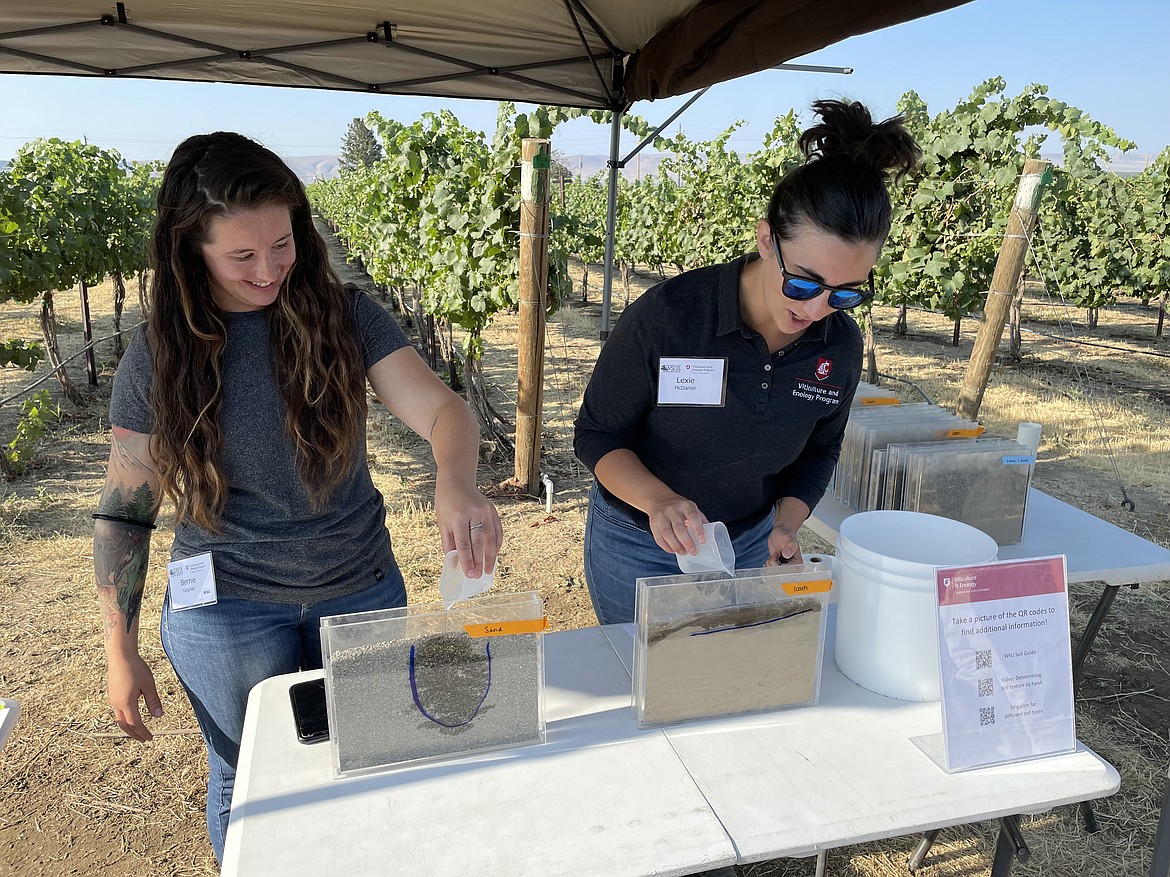Studying the dirt beneath your feet
PROSSER — To get the most out of your irrigation equipment, the chemicals you put on your crops, and the water you use, it helps to know something about the soil you’re growing in.
To know what kind of soils you have, what kind of layers you have, and how deep they go.
And the only real way to do that, according Bernie Gagnier, a graduate student in Washington State University’s viticulture program, is to grab a shovel and dig.
“Anywhere you can actually see the layers in the soil. You actually want to go in there and dig and see what you’re working with and see what boundary layers you have and see where they are,” Gagnier said.
Gagnier, along with fellow graduate student Lexie McDaniel and WSU Extension Professor Michelle Moyer, talked about soil as part of the Viticulture Field Day at WSU’s Irrigated Agricultural Research and Extension Center-Roza Research Farm in Prosser jointly sponsored and organized by the university and the Washington State Grape Society.
It’s important to know what kind of soil you are growing in — how small the particles and how tightly packed they are — because that will determine how fast water percolates through the soil and, in turn, an optimal irrigation and chemigation strategy, Gagnier said.
“When you’re looking at something with smaller pore sizes, smaller particle sizes like a silt or loam or clay, those smaller sizes in both particles and pores, hold a little bit more water,” she said. “It’s not going to just run right through it, it’s going to look for ways to percolate through the soil and it’s going to stay in a given area a little bit longer.”
Both Gagnier and McDaniel demonstrate by pouring both water and blue dye to simulate chemicals into a series of clear containers of various types of crude soil — large grains of sand, tightly packed loams and clays, and various different layered samples — to show the ways water moves through different kinds of soils.
“Watching water drip is always great, right? We’re here for your early morning meditation,” Gagnier said after she finished pouring.
In the sandy soils, the water moved quickly and vertically, while in the tighter packed soils the water moved more slowly, took its time, and spread out horizontally as it moved down through the soil.
“Now you can see it, we have much more of a column vertical movement through the sand, much more horizontal through the loam,” McDaniel said.
Boundary layers — silt atop sand, or sand atop silt — further complicates how water moves through soil, and the irrigation strategy growers need to adopt.
Gagnier said with tightly packed soils, growers will probably want to water less frequently, but for longer set times, while sandy soils will require shorter but more frequent watering.
But it’s also important to find where the root layer is in relation to how water moves through a soil, so chemicals aren’t wasted, Gagnier said.
“Dug in our vineyard after an 8-hour irrigation set, we found that our water infiltration went down to 24 inches, so that’s where we hit dry soil. But our root zone was at 12 inches,” she said.
“So we were like, ‘We want to put on our chemigation on the second half, we don’t want to do it on our first half and push it down to 24 and go right past the roots,’” Gagnier explained. “We really want it to be in that second half so it settles right along that root zone there to get the most effective use out of our chemigation.”
Gagnier and Moyer also said growers need to check how quickly water flows from their irrigation emitters.
“Usually, about 50% of the people who call me don’t actually know what their emitter flow rate is, and I always get that question, what type of emitter flow rate should I have in my vineyard,” Moyer said. “It’s about your soil type.”
Moyer said it’s also important to recognize adding organic matter to soil will change the soil type and create a boundary layer, so it’s important to make sure to add enough new soil so roots have a chance to establish themselves and branch out.
“It’s like when you plant a plant at your house, if you just dig a really tiny hole and plunk a landscape rose in and your soil is hard as a rock, those roots will not grow out of that. It creates a pot-like experience and that’s something to think about, too,” Moyer said.
“Sometimes when we do things thinking we are going to help the plant, we’re not helping,” Moyer added.
Charles H. Featherstone can be reached at cfeatherstone@columbiabasinherald.com.


